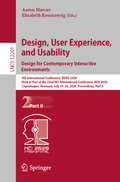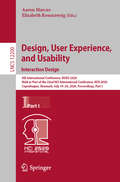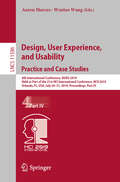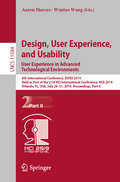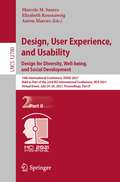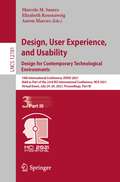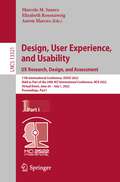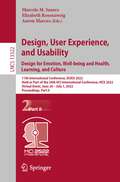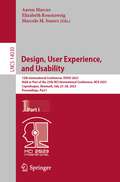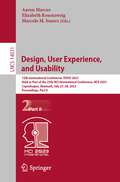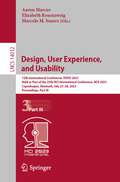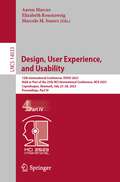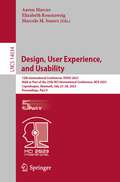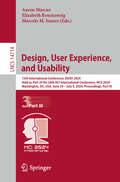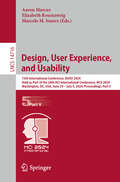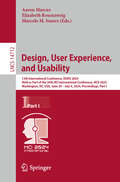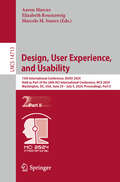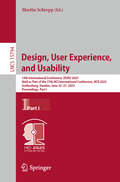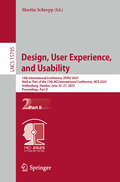- Table View
- List View
Design, User Experience, and Usability. Application Domains: 8th International Conference, DUXU 2019, Held as Part of the 21st HCI International Conference, HCII 2019, Orlando, FL, USA, July 26–31, 2019, Proceedings, Part III (Lecture Notes in Computer Science #11585)
by Aaron Marcus Wentao WangThe four-volume set LNCS 11583, 11584, 11585, and 11586 constitutes the proceedings of the 8th International Conference on Design, User Experience, and Usability, DUXU 2019, held as part of the 21st International Conference, HCI International 2019, which took place in Orlando, FL, USA, in July 2019.The total of 1274 papers and 209 posters included in the 35 HCII 2019 proceedings volumes was carefully reviewed and selected from 5029 submissions.DUXU 2019 includes a total of 167 regular papers, organized in the following topical sections: design philosophy; design theories, methods, and tools; user requirements, preferences emotions and personality; visual DUXU; DUXU for novel interaction techniques and devices; DUXU and robots; DUXU for AI and AI for DUXU; dialogue, narrative, storytelling; DUXU for automated driving, transport, sustainability and smart cities; DUXU for cultural heritage; DUXU for well-being; DUXU for learning; user experience evaluation methods and tools; DUXU practice; DUXU case studies.
Design, User Experience, and Usability. Case Studies in Public and Personal Interactive Systems: 9th International Conference, DUXU 2020, Held as Part of the 22nd HCI International Conference, HCII 2020, Copenhagen, Denmark, July 19–24, 2020, Proceedings, Part III (Lecture Notes in Computer Science #12202)
by Aaron Marcus Elizabeth RosenzweigThis book constitutes the refereed proceedings of the 9th International Conference on Design, User Experience, and Usability, DUXU 2020, held as part of the 22nd International Conference on Human-Computer Interaction, HCII 2020, in Copenhagen, Denmark, in July 2020. The conference was held virtually due to the COVID-19 pandemic. From a total of 6326 submissions, a total of 1439 papers and 238 posters has been accepted for publication in the HCII 2020 proceedings. The 51 papers included in this volume were organized in topical sections on interactions in public, urban and rural contexts; UX design for health and well-being; DUXU for creativity, learning and collaboration; DUXU for culture and tourism.
Design, User Experience, and Usability. Design Philosophy and Theory: 8th International Conference, DUXU 2019, Held as Part of the 21st HCI International Conference, HCII 2019, Orlando, FL, USA, July 26–31, 2019, Proceedings, Part I (Lecture Notes in Computer Science #11583)
by Aaron Marcus Wentao WangThe four-volume set LNCS 11583, 11584, 11585, and 11586 constitutes the proceedings of the 8th International Conference on Design, User Experience, and Usability, DUXU 2019, held as part of the 21st International Conference, HCI International 2019, which took place in Orlando, FL, USA, in July 2019.The total of 1274 papers and 209 posters included in the 35 HCII 2019 proceedings volumes was carefully reviewed and selected from 5029 submissions.DUXU 2019 includes a total of 167 regular papers, organized in the following topical sections: design philosophy; design theories, methods, and tools; user requirements, preferences emotions and personality; visual DUXU; DUXU for novel interaction techniques and devices; DUXU and robots; DUXU for AI and AI for DUXU; dialogue, narrative, storytelling; DUXU for automated driving, transport, sustainability and smart cities; DUXU for cultural heritage; DUXU for well-being; DUXU for learning; user experience evaluation methods and tools; DUXU practice; DUXU case studies.
Design, User Experience, and Usability. Design for Contemporary Interactive Environments: 9th International Conference, DUXU 2020, Held as Part of the 22nd HCI International Conference, HCII 2020, Copenhagen, Denmark, July 19–24, 2020, Proceedings, Part II (Lecture Notes in Computer Science #12201)
by Aaron Marcus Elizabeth RosenzweigThis book constitutes the refereed proceedings of the 9th International Conference on Design, User Experience, and Usability, DUXU 2020, held as part of the 22nd International Conference on Human-Computer Interaction, HCII 2020, in Copenhagen, Denmark, in July 2020. The conference was held virtually due to the COVID-19 pandemic. From a total of 6326 submissions, a total of 1439 papers and 238 posters has been accepted for publication in the HCII 2020 proceedings. The 50 papers included in this volume were organized in topical sections on interactions in intelligent and IoT environments, usability aspects of handheld and mobile devices, designing games and immersive experiences, and UX studies in automotive and transport.
Design, User Experience, and Usability. Interaction Design: 9th International Conference, DUXU 2020, Held as Part of the 22nd HCI International Conference, HCII 2020, Copenhagen, Denmark, July 19–24, 2020, Proceedings, Part I (Lecture Notes in Computer Science #12200)
by Aaron Marcus Elizabeth RosenzweigThis book constitutes the refereed proceedings of the 9th International Conference on Design, User Experience, and Usability, DUXU 2020, held as part of the 22nd International Conference on Human-Computer Interaction, HCII 2020, in Copenhagen, Denmark, in July 2020. The conference was held virtually due to the COVID-19 pandemic.From a total of 6326 submissions, a total of 1439 papers and 238 posters has been accepted for publication in the HCII 2020 proceedings. The 40 papers included in this volume were organized in topical sections on UX design methods, tools and guidelines, interaction design and information visualization, and emotional design.
Design, User Experience, and Usability. Practice and Case Studies: 8th International Conference, DUXU 2019, Held as Part of the 21st HCI International Conference, HCII 2019, Orlando, FL, USA, July 26–31, 2019, Proceedings, Part IV (Lecture Notes in Computer Science #11586)
by Aaron Marcus Wentao WangThe four-volume set LNCS 11583, 11584, 11585, and 11586 constitutes the proceedings of the 8th International Conference on Design, User Experience, and Usability, DUXU 2019, held as part of the 21st International Conference, HCI International 2019, which took place in Orlando, FL, USA, in July 2019.The total of 1274 papers and 209 posters included in the 35 HCII 2019 proceedings volumes was carefully reviewed and selected from 5029 submissions.DUXU 2019 includes a total of 167 regular papers, organized in the following topical sections: design philosophy; design theories, methods, and tools; user requirements, preferences emotions and personality; visual DUXU; DUXU for novel interaction techniques and devices; DUXU and robots; DUXU for AI and AI for DUXU; dialogue, narrative, storytelling; DUXU for automated driving, transport, sustainability and smart cities; DUXU for cultural heritage; DUXU for well-being; DUXU for learning; user experience evaluation methods and tools; DUXU practice; DUXU case studies.
Design, User Experience, and Usability. User Experience in Advanced Technological Environments: 8th International Conference, DUXU 2019, Held as Part of the 21st HCI International Conference, HCII 2019, Orlando, FL, USA, July 26–31, 2019, Proceedings, Part II (Lecture Notes in Computer Science #11584)
by Aaron Marcus Wentao WangThe four-volume set LNCS 11583, 11584, 11585, and 11586 constitutes the proceedings of the 8th International Conference on Design, User Experience, and Usability, DUXU 2019, held as part of the 21st International Conference, HCI International 2019, which took place in Orlando, FL, USA, in July 2019.The total of 1274 papers and 209 posters included in the 35 HCII 2019 proceedings volumes was carefully reviewed and selected from 5029 submissions.DUXU 2019 includes a total of 167 regular papers, organized in the following topical sections: design philosophy; design theories, methods, and tools; user requirements, preferences emotions and personality; visual DUXU; DUXU for novel interaction techniques and devices; DUXU and robots; DUXU for AI and AI for DUXU; dialogue, narrative, storytelling; DUXU for automated driving, transport, sustainability and smart cities; DUXU for cultural heritage; DUXU for well-being; DUXU for learning; user experience evaluation methods and tools; DUXU practice; DUXU case studies.
Design, User Experience, and Usability: 10th International Conference, DUXU 2021, Held as Part of the 23rd HCI International Conference, HCII 2021, Virtual Event, July 24–29, 2021, Proceedings, Part I (Lecture Notes in Computer Science #12779)
by Aaron Marcus Marcelo M. Soares Elizabeth RosenzweigThis three volume set LNCS 12779, 12780, and 12781 constitutes the refereed proceedings of the 10th International Conference on Design, User Experience, and Usability, DUXU 2021, held as part of the 23rd International Conference, HCI International 2021, which took place in July 2021. Due to COVID-19 pandemic the conference was held virtually.The total of 1276 papers and 241 poster papers included in the 39 HCII 2021 proceedings volumes was carefully reviewed and selected from 5222 submissions. The regular papers of DUXU 2021 are organized in topical sections named: UX Design Methods and Techniques; Methods and Techniques for UX Research; Visual Languages and Information Visualization; Design Education and Practice.
Design, User Experience, and Usability: 10th International Conference, DUXU 2021, Held as Part of the 23rd HCI International Conference, HCII 2021, Virtual Event, July 24–29, 2021, Proceedings, Part II (Lecture Notes in Computer Science #12780)
by Aaron Marcus Marcelo M. Soares Elizabeth RosenzweigThis three volume set LNCS 12779, 12780, and 12781 constitutes the refereed proceedings of the 10th International Conference on Design, User Experience, and Usability, DUXU 2021, held as part of the 23rd International Conference, HCI International 2021, which took place in July 2021. Due to COVID-19 pandemic the conference was held virtually. The total of 1276 papers and 241 poster papers included in the 39 HCII 2021 proceedings volumes was carefully reviewed and selected from 5222 submissions. The regular papers of DUXU 2021 are organized in topical sections named: Experience Design across Cultures; Design for Inclusion and Social Development¸ Design for Health and Well-being; DUXU Case Studies.
Design, User Experience, and Usability: 10th International Conference, DUXU 2021, Held as Part of the 23rd HCI International Conference, HCII 2021, Virtual Event, July 24–29, 2021, Proceedings, Part III (Lecture Notes in Computer Science #12781)
by Aaron Marcus Marcelo M. Soares Elizabeth RosenzweigThis three volume set LNCS 12779, 12780, and 12781 constitutes the refereed proceedings of the 10th International Conference on Design, User Experience, and Usability, DUXU 2021, held as part of the 23rd International Conference, HCI International 2021, which took place in July 2021. Due to COVID-19 pandemic the conference was held virtually. The total of 1276 papers and 241 poster papers included in the 39 HCII 2021 proceedings volumes was carefully reviewed and selected from 5222 submissions. The regular papers of DUXU 2021 are organized in topical sections named: Mobile UX Research and Design; DUXU for Extended Reality; DUXU for the Creative Industries; Usability and UX Studies.
Design, User Experience, and Usability: 11th International Conference, DUXU 2022, Held as Part of the 24th HCI International Conference, HCII 2022, Virtual Event, June 26 – July 1, 2022, Proceedings, Part I (Lecture Notes in Computer Science #13321)
by Aaron Marcus Marcelo M. Soares Elizabeth RosenzweigThis book constitutes the refereed proceedings of the 11th International Conference on Design, User Experience, and Usability, DUXU 2022, held as part of the 23rd International Conference, HCI International 2022, which was held virtually in June/July 2022. The total of 1271 papers and 275 posters included in the HCII 2022 proceedings was carefully reviewed and selected from 5487 submissions. The DUXU 2022 proceedings comprise three volumes; they were organized in the following topical sections: Part I: Processes, Methods, and Tools for UX Design and Evaluation; User Requirements, Preferences, and UX Influential Factors; Usability, Acceptance, and User Experience Assessment. Part II: Emotion, Motivation, and Persuasion Design; Design for Well-being and Health.- Learning Experience Design; Globalization, Localization, and Culture Issues. Part III: Design Thinking and Philosophy; DUXU Case Studies; Design and User Experience in Emerging Technologies.
Design, User Experience, and Usability: 11th International Conference, DUXU 2022, Held as Part of the 24th HCI International Conference, HCII 2022, Virtual Event, June 26 – July 1, 2022, Proceedings, Part II (Lecture Notes in Computer Science #13322)
by Aaron Marcus Marcelo M. Soares Elizabeth RosenzweigThis book constitutes the refereed proceedings of the 11th International Conference on Design, User Experience, and Usability, DUXU 2022, held as part of the 23rd International Conference, HCI International 2022, which was held virtually in June/July 2022.The total of 1271 papers and 275 posters included in the HCII 2022 proceedings was carefully reviewed and selected from 5487 submissions. The DUXU 2022 proceedings comprise three volumes; they were organized in the following topical sections: Part I: Processes, Methods, and Tools for UX Design and Evaluation; User Requirements, Preferences, and UX Influential Factors; Usability, Acceptance, and User Experience Assessment. Part II: Emotion, Motivation, and Persuasion Design; Design for Well-being and Health.- Learning Experience Design; Globalization, Localization, and Culture Issues. Part III: Design Thinking and Philosophy; DUXU Case Studies; Design and User Experience in Emerging Technologies.
Design, User Experience, and Usability: 11th International Conference, DUXU 2022, Held as Part of the 24th HCI International Conference, HCII 2022, Virtual Event, June 26 – July 1, 2022, Proceedings, Part III (Lecture Notes in Computer Science #13323)
by Aaron Marcus Marcelo M. Soares Elizabeth RosenzweigThis book constitutes the refereed proceedings of the 11th International Conference on Design, User Experience, and Usability, DUXU 2022, held as part of the 23rd International Conference, HCI International 2022, which was held virtually in June/July 2022.The total of 1271 papers and 275 posters included in the HCII 2022 proceedings was carefully reviewed and selected from 5487 submissions. The DUXU 2022 proceedings comprise three volumes; they were organized in the following topical sections: Part I: Processes, Methods, and Tools for UX Design and Evaluation; User Requirements, Preferences, and UX Influential Factors; Usability, Acceptance, and User Experience Assessment. Part II: Emotion, Motivation, and Persuasion Design; Design for Well-being and Health.- Learning Experience Design; Globalization, Localization, and Culture Issues. Part III: Design Thinking and Philosophy; DUXU Case Studies; Design and User Experience in Emerging Technologies.
Design, User Experience, and Usability: 12th International Conference, DUXU 2023, Held as Part of the 25th HCI International Conference, HCII 2023, Copenhagen, Denmark, July 23–28, 2023, Proceedings, Part I (Lecture Notes in Computer Science #14030)
by Aaron Marcus Marcelo M. Soares Elizabeth RosenzweigThis 5-volume HCII-DUXU 2023 book set constitutes the refereed proceedings of the 12th International Conference on Design, User Experience, and Usability, DUXU 2023, held as part of the 24th International Conference, HCI International 2023, which took place in Copenhagen, Denmark, in July 2023.A total of 1578 papers and 396 posters have been accepted for publication in the HCII 2023 proceedings from a total of 7472 submissions. The papers included in this volume set were organized in topical sections as follows: Part I: Design methods, tools and practices; emotional and persuasive design; Part II: Design case studies; and creativity and design education; Part III: Evaluation methods and techniques; and usability, user experience and technology acceptance studies; Part IV: Designing learning experiences; and chatbots, conversational agents and robots: design and user experience; Part V: DUXU for cultural heritage; and DUXU for health and wellbeing.
Design, User Experience, and Usability: 12th International Conference, DUXU 2023, Held as Part of the 25th HCI International Conference, HCII 2023, Copenhagen, Denmark, July 23–28, 2023, Proceedings, Part II (Lecture Notes in Computer Science #14031)
by Aaron Marcus Marcelo M. Soares Elizabeth RosenzweigThis 5-volume HCII-DUXU 2023 book set constitutes the refereed proceedings of the 12th International Conference on Design, User Experience, and Usability, DUXU 2023, held as part of the 24th International Conference, HCI International 2023, which took place in Copenhagen, Denmark, in July 2023.A total of 1578 papers and 396 posters have been accepted for publication in the HCII 2023 proceedings from a total of 7472 submissions. The papers included in this volume set were organized in topical sections as follows: Part I: Design methods, tools and practices; emotional and persuasive design; Part II: Design case studies; and creativity and design education; Part III: Evaluation methods and techniques; and usability, user experience and technology acceptance studies; Part IV: Designing learning experiences; and chatbots, conversational agents and robots: design and user experience; Part V: DUXU for cultural heritage; and DUXU for health and wellbeing.
Design, User Experience, and Usability: 12th International Conference, DUXU 2023, Held as Part of the 25th HCI International Conference, HCII 2023, Copenhagen, Denmark, July 23–28, 2023, Proceedings, Part III (Lecture Notes in Computer Science #14032)
by Aaron Marcus Marcelo M. Soares Elizabeth RosenzweigThis 5-volume HCII-DUXU 2023 book set constitutes the refereed proceedings of the 12th International Conference on Design, User Experience, and Usability, DUXU 2023, held as part of the 24th International Conference, HCI International 2023, which took place in Copenhagen, Denmark, in July 2023.A total of 1578 papers and 396 posters have been accepted for publication in the HCII 2023 proceedings from a total of 7472 submissions. The papers included in this volume set were organized in topical sections as follows: Part I: Design methods, tools and practices; emotional and persuasive design; Part II: Design case studies; and creativity and design education; Part III: Evaluation methods and techniques; and usability, user experience and technology acceptance studies; Part IV: Designing learning experiences; and chatbots, conversational agents and robots: design and user experience; Part V: DUXU for cultural heritage; and DUXU for health and wellbeing.
Design, User Experience, and Usability: 12th International Conference, DUXU 2023, Held as Part of the 25th HCI International Conference, HCII 2023, Copenhagen, Denmark, July 23–28, 2023, Proceedings, Part IV (Lecture Notes in Computer Science #14033)
by Aaron Marcus Marcelo M. Soares Elizabeth RosenzweigThis 5-volume HCII-DUXU 2023 book set constitutes the refereed proceedings of the 12th International Conference on Design, User Experience, and Usability, DUXU 2023, held as part of the 24th International Conference, HCI International 2023, which took place in Copenhagen, Denmark, in July 2023.A total of 1578 papers and 396 posters have been accepted for publication in the HCII 2023 proceedings from a total of 7472 submissions. The papers included in this volume set were organized in topical sections as follows: Part I: Design methods, tools and practices; emotional and persuasive design; Part II: Design case studies; and creativity and design education; Part III: Evaluation methods and techniques; and usability, user experience and technology acceptance studies; Part IV: Designing learning experiences; and chatbots, conversational agents and robots: design and user experience; Part V: DUXU for cultural heritage; and DUXU for health and wellbeing.
Design, User Experience, and Usability: 12th International Conference, DUXU 2023, Held as Part of the 25th HCI International Conference, HCII 2023, Copenhagen, Denmark, July 23–28, 2023, Proceedings, Part V (Lecture Notes in Computer Science #14034)
by Aaron Marcus Marcelo M. Soares Elizabeth RosenzweigThis 5-volume HCII-DUXU 2023 book set constitutes the refereed proceedings of the 12th International Conference on Design, User Experience, and Usability, DUXU 2023, held as part of the 24th International Conference, HCI International 2023, which took place in Copenhagen, Denmark, in July 2023.A total of 1578 papers and 396 posters have been accepted for publication in the HCII 2023 proceedings from a total of 7472 submissions. The papers included in this volume set were organized in topical sections as follows: Part I: Design methods, tools and practices; emotional and persuasive design; Part II: Design case studies; and creativity and design education; Part III: Evaluation methods and techniques; and usability, user experience and technology acceptance studies; Part IV: Designing learning experiences; and chatbots, conversational agents and robots: design and user experience; Part V: DUXU for cultural heritage; and DUXU for health and wellbeing.
Design, User Experience, and Usability: 13th International Conference, DUXU 2024, Held as Part of the 26th HCI International Conference, HCII 2024, Washington, DC, USA, June 29 – July 4, 2024, Proceedings, Part III (Lecture Notes in Computer Science #14714)
by Aaron Marcus Marcelo M. Soares Elizabeth RosenzweigThis five-volume set LNCS 14712-14716 constitutes the refereed proceedings of the 13th International Conference on Design, User Experience, and Usability, DUXU 2024, held as part of the 26th International Conference, HCI International 2024, in Washington, DC, USA, during June 29 – July 4, 2024. The total of 1271 papers and 309 posters included in the HCII 2024 proceedings was carefully reviewed and selected from 5108 submissions. The DUXU 2024 proceedings were organized in the following topical sections: Part I: Information Visualization and Interaction Design; Usability Testing and User Experience Evaluation. Part II: Designing Interactions for Intelligent Environments; Automotive Interactions and Smart Mobility Solutions; Speculative Design and Creativity. Part III: User Experience Design for Inclusion and Diversity; Human-Centered Design for Social Impact. Part IV: Designing Immersive Experiences across Contexts; Technology, Design, and Learner Engagement; User Experience in Tangible and Intangible Cultural Heritage. Part V: Innovative Design for Enhanced User Experience; Innovations in Product and Service Design.
Design, User Experience, and Usability: 13th International Conference, DUXU 2024, Held as Part of the 26th HCI International Conference, HCII 2024, Washington, DC, USA, June 29 – July 4, 2024, Proceedings, Part IV (Lecture Notes in Computer Science #14715)
by Aaron Marcus Marcelo M. Soares Elizabeth RosenzweigThis five-volume set LNCS 14712-14716 constitutes the refereed proceedings of the 13th International Conference on Design, User Experience, and Usability, DUXU 2024, held as part of the 26th International Conference, HCI International 2024, in Washington, DC, USA, during June 29 – July 4, 2024. The total of 1271 papers and 309 posters included in the HCII 2024 proceedings was carefully reviewed and selected from 5108 submissions. The DUXU 2024 proceedings were organized in the following topical sections: Part I: Information Visualization and Interaction Design; Usability Testing and User Experience Evaluation. Part II: Designing Interactions for Intelligent Environments; Automotive Interactions and Smart Mobility Solutions; Speculative Design and Creativity. Part III: User Experience Design for Inclusion and Diversity; Human-Centered Design for Social Impact. Part IV: Designing Immersive Experiences across Contexts; Technology, Design, and Learner Engagement; User Experience in Tangible and Intangible Cultural Heritage. Part V: Innovative Design for Enhanced User Experience; Innovations in Product and Service Design.
Design, User Experience, and Usability: 13th International Conference, DUXU 2024, Held as Part of the 26th HCI International Conference, HCII 2024, Washington, DC, USA, June 29 – July 4, 2024, Proceedings, Part V (Lecture Notes in Computer Science #14716)
by Aaron Marcus Marcelo M. Soares Elizabeth RosenzweigThis five-volume set LNCS 14712-14716 constitutes the refereed proceedings of the 13th International Conference on Design, User Experience, and Usability, DUXU 2024, held as part of the 26th International Conference, HCI International 2024, in Washington, DC, USA, during June 29 – July 4, 2024. The total of 1271 papers and 309 posters included in the HCII 2024 proceedings was carefully reviewed and selected from 5108 submissions. The DUXU 2024 proceedings were organized in the following topical sections: Part I: Information Visualization and Interaction Design; Usability Testing and User Experience Evaluation. Part II: Designing Interactions for Intelligent Environments; Automotive Interactions and Smart Mobility Solutions; Speculative Design and Creativity. Part III: User Experience Design for Inclusion and Diversity; Human-Centered Design for Social Impact. Part IV: Designing Immersive Experiences across Contexts; Technology, Design, and Learner Engagement; User Experience in Tangible and Intangible Cultural Heritage. Part V: Innovative Design for Enhanced User Experience; Innovations in Product and Service Design.
Design, User Experience, and Usability: 13th International Conference, DUXU 2024, Held as Part of the 26th HCI International Conference, HCII 2024, Washington, DC, USA, June 29–July 4, 2024, Proceedings, Part I (Lecture Notes in Computer Science #14712)
by Aaron Marcus Marcelo M. Soares Elizabeth RosenzweigThis five-volume set LNCS 14712-14716 constitutes the refereed proceedings of the 13th International Conference on Design, User Experience, and Usability, DUXU 2024, held as part of the 26th International Conference, HCI International 2024, in Washington, DC, USA, during June 29 – July 4, 2024. The total of 1271 papers and 309 posters included in the HCII 2024 proceedings was carefully reviewed and selected from 5108 submissions. The DUXU 2024 proceedings were organized in the following topical sections: Part I: Information Visualization and Interaction Design; Usability Testing and User Experience Evaluation. Part II: Designing Interactions for Intelligent Environments; Automotive Interactions and Smart Mobility Solutions; Speculative Design and Creativity. Part III: User Experience Design for Inclusion and Diversity; Human-Centered Design for Social Impact. Part IV: Designing Immersive Experiences across Contexts; Technology, Design, and Learner Engagement; User Experience in Tangible and Intangible Cultural Heritage. Part V: Innovative Design for Enhanced User Experience; Innovations in Product and Service Design.
Design, User Experience, and Usability: 13th International Conference, DUXU 2024, Held as Part of the 26th HCI International Conference, HCII 2024, Washington, DC, USA, June 29–July 4, 2024, Proceedings, Part II (Lecture Notes in Computer Science #14713)
by Aaron Marcus Marcelo M. Soares Elizabeth RosenzweigThis five-volume set LNCS 14712-14716 constitutes the refereed proceedings of the 13th International Conference on Design, User Experience, and Usability, DUXU 2024, held as part of the 26th International Conference, HCI International 2024, in Washington, DC, USA, during June 29 – July 4, 2024. The total of 1271 papers and 309 posters included in the HCII 2024 proceedings was carefully reviewed and selected from 5108 submissions. The DUXU 2024 proceedings were organized in the following topical sections: Part I: Information Visualization and Interaction Design; Usability Testing and User Experience Evaluation. Part II: Designing Interactions for Intelligent Environments; Automotive Interactions and Smart Mobility Solutions; Speculative Design and Creativity. Part III: User Experience Design for Inclusion and Diversity; Human-Centered Design for Social Impact. Part IV: Designing Immersive Experiences across Contexts; Technology, Design, and Learner Engagement; User Experience in Tangible and Intangible Cultural Heritage. Part V: Innovative Design for Enhanced User Experience; Innovations in Product and Service Design.
Design, User Experience, and Usability: 14th International Conference, DUXU 2025, Held as Part of the 27th HCI International Conference, HCII 2025, Gothenburg, Sweden, June 22–27, 2025, Proceedings, Part I (Lecture Notes in Computer Science #15794)
by Martin SchreppThis six-volume set LNCS 15794-15799 constitutes the refereed proceedings of the 14th International Conference on Design, User Experience, and Usability, DUXU 2025, held as part of the 27th International Conference on Human-Computer Interaction, HCII 2025, in Gothenburg, Sweden, during June 22-27, 2025. The total of 1430 papers and 355 posters included in the HCII 2025 proceedings was carefully reviewed and selected from 7972 submissions.The six volumes cover the following topics:Part I: Information design and visualization; emotional interaction and persuasive design; and interactive systems and user behavior.Part II: UX design and evaluation methodologies; inclusive design and accessible experiences; and product and industrial design.Part III: Design and the digital transmission of culture; design for arts and creativity; and designing for health and therapeutic experiences.Part IV: Consumer experience and service design; design and evaluation of technology-enhanced learning; and UX in automotive and transportation.Part V: Design education and professional practice; and human-centered design and interactive experiences.Part VI: AI and the future of UX design; and UX in AI and emerging technologies.
Design, User Experience, and Usability: 14th International Conference, DUXU 2025, Held as Part of the 27th HCI International Conference, HCII 2025, Gothenburg, Sweden, June 22–27, 2025, Proceedings, Part II (Lecture Notes in Computer Science #15795)
by Martin SchreppThis six-volume set LNCS 15794-15799 constitutes the refereed proceedings of the 14th International Conference on Design, User Experience, and Usability, DUXU 2025, held as part of the 27th International Conference on Human-Computer Interaction, HCII 2025, in Gothenburg, Sweden, during June 22-27, 2025. The total of 1430 papers and 355 posters included in the HCII 2025 proceedings was carefully reviewed and selected from 7972 submissions.The six volumes cover the following topics:Part I: Information design and visualization; emotional interaction and persuasive design; and interactive systems and user behavior.Part II: UX design and evaluation methodologies; inclusive design and accessible experiences; and product and industrial design.Part III: Design and the digital transmission of culture; design for arts and creativity; and designing for health and therapeutic experiences.Part IV: Consumer experience and service design; design and evaluation of technology-enhanced learning; and UX in automotive and transportation.Part V: Design education and professional practice; and human-centered design and interactive experiences.Part VI: AI and the future of UX design; and UX in AI and emerging technologies.



